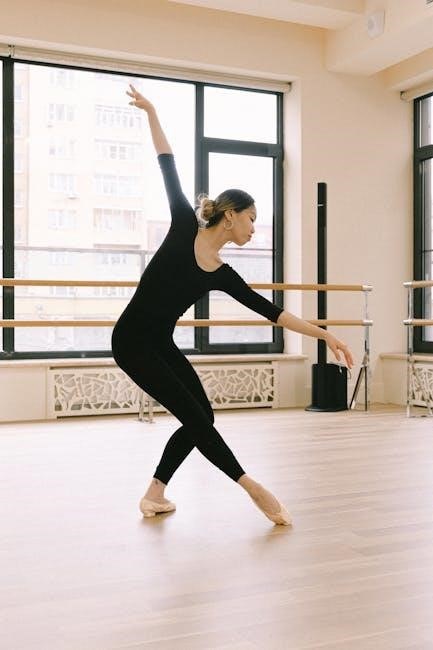Welcome to the world of rhythm exercises, essential for musicians and learners alike. These structured activities help develop timing, coordination, and musical expression. Whether through clapping, tapping, or playing instruments, rhythm exercises provide a foundational skill set. Explore various time signatures, rhythmic patterns, and techniques to enhance your musical understanding. With resources like PDF guides, apps, and worksheets, mastering rhythm has never been more accessible. Start your journey to musical excellence with these engaging and effective exercises.
Importance of Rhythm in Music
Rhythm is the heartbeat of music, providing structure and timing to melodies and harmonies. It unifies musical elements, creating a sense of pulse and flow. Rhythm enhances coordination, timing, and expression, making it essential for all musicians. Whether in simple clapping exercises or complex compositions, rhythm is the foundation that brings music to life. It allows for emotional connection and storytelling through patterns and accents. Developing rhythmic skills is crucial for musicians, as it improves performance quality and musical understanding. Rhythm exercises, such as those in 4/4 and 3/4 time, help build this foundation. They are universal, applicable to all genres, and vital for any musician seeking to master their craft. Rhythm truly is the backbone of music.
Benefits of Practicing Rhythm Exercises
Practicing rhythm exercises offers numerous benefits for musicians of all levels. It enhances timing accuracy, coordination, and overall musical expression. Rhythm exercises improve cognitive skills, boosting memory and concentration. They also strengthen physical dexterity, essential for instrumentalists. Regular practice fosters a deeper connection to music, allowing for more nuanced performances. Additionally, rhythm exercises reduce performance anxiety by building confidence and control. They are versatile, applicable to various genres and instruments, ensuring well-rounded musical development. With consistent practice, musicians can achieve a stronger sense of rhythm, elevating their playing and appreciation of music. These exercises are a cornerstone of musical training, providing lifelong benefits for aspiring and accomplished musicians alike.

Understanding Time Signatures
Time signatures are essential in music, guiding rhythm and meter. They appear as two numbers, indicating beats per measure and note values. Common signatures include 4/4 and 3/4, used in exercises to practice timing and structure. Mastering time signatures enhances rhythmic accuracy and musical interpretation. These symbols provide a framework for clapping, tapping, and playing, ensuring synchronization and consistency. Understanding time signatures is fundamental for all musicians, offering clarity and direction in musical performance. They are a cornerstone of rhythm exercises, helping to build a strong foundation in music theory and practice.
Common Time Signatures (4/4, 3/4)
The most frequently encountered time signatures in music are 4/4 and 3/4. The 4/4 time signature, often called “common time,” is widely used in popular music. It indicates four beats per measure, with the quarter note receiving one beat. This structure is intuitive for many listeners and is commonly used in rhythm exercises to practice timing and coordination. The 3/4 time signature, or “waltz time,” features three beats per measure, with a strong emphasis on the first beat. It is ideal for practicing triple meter and is often used in clapping or tapping exercises to develop a sense of rhythmic flow. Both signatures are fundamental for building a strong rhythmic foundation and are frequently included in rhythm exercises PDFs for musicians and learners alike.
How to Read and Write Time Signatures
Reading and writing time signatures is a fundamental skill in music. A time signature consists of two numbers stacked vertically, indicating the rhythmic structure of a piece. The top number specifies how many beats are in each measure, while the bottom number denotes which note value receives one beat (e.g., 4 for a quarter note). To write a time signature, place a vertical line on the left side of the staff, followed by the two numbers. For example, in 4/4 time, there are four quarter-note beats per measure. Practicing rhythm exercises with time signatures helps musicians internalize timing and coordination. Rhythm exercises PDFs often include activities to clap, tap, or play along with these structures, reinforcing understanding and application.
Basic Rhythm Exercises
Basic rhythm exercises introduce foundational skills, helping musicians grasp timing, beats, and rests. These exercises involve simple patterns, clapping, and playing instruments to develop rhythmic accuracy and consistency.
Clapping and Tapping Exercises
Clapping and tapping exercises are foundational for developing rhythm skills. They involve physical movement to emphasize beats, helping musicians internalize timing and tempo. Start with simple patterns like clapping on every beat in 4/4 time, then progress to more complex rhythms. Tapping exercises can be done on surfaces like desks or knees, reinforcing coordination. These activities are accessible to all skill levels. For beginners, clapping along with a metronome or recorded music enhances accuracy. Advanced practitioners can explore syncopation or polyrhythms. Incorporating clapping and tapping into daily practice improves timing, dexterity, and overall rhythmic awareness, making them essential tools for musicians and learners alike.
Practicing with Notes and Rests
Practicing with notes and rests is crucial for mastering rhythm. Start by performing simple exercises, such as clapping or playing quarter notes and rests in 4/4 time. Gradually introduce eighth notes, sixteenth notes, and dotted rhythms to build complexity. Use rhythm worksheets or flashcards to visualize patterns. Begin with slow tempos and increase speed as confidence grows. Incorporate rests to improve timing accuracy, as they add silent intervals that require precise counting. Combine notes and rests in various time signatures to enhance adaptability. For visual learners, write out rhythms and mark stress points or accents. Regular practice with notes and rests strengthens musical timing, coordination, and overall rhythmic precision, making it a cornerstone of rhythm exercises.
Simple Rhythmic Patterns (A-H)
Simple rhythmic patterns, labeled A to H, provide foundational exercises for developing timing and coordination. These patterns typically involve basic note values such as quarter notes, eighth notes, and rests in common time signatures like 4/4 or 3/4. Pattern A might consist of four quarter notes, while Pattern B introduces a rest, followed by three quarter notes. As you progress, patterns incorporate syncopation and varied durations, such as eighth notes and sixteenth notes. These exercises are designed to be practiced with a metronome to ensure accuracy. Start by clapping or tapping along, then advance to playing an instrument. Consistency is key to mastering these patterns, which build a strong rhythmic foundation and prepare you for more complex rhythms.

Advanced Rhythm Techniques
Advanced techniques involve complex time signatures, syncopation, and polyrhythms, refining timing, coordination, and musical expression.
Syncopation and Complex Rhythms
Syncopation involves emphasizing off-beat or unexpected parts of a rhythm, creating a more dynamic and complex musical feel. These exercises challenge timing and coordination, requiring precise execution. Complex rhythms often combine multiple time signatures or layered patterns, enhancing musical expression. Practicing syncopation helps develop a stronger sense of rhythm and musicality. Start with simple syncopated patterns, then gradually incorporate more intricate designs. Use rhythm exercises PDFs to explore advanced syncopation techniques, such as dotted eighth notes and sixteenth note rests. These exercises are ideal for drummers, percussionists, and instrumentalists seeking to refine their rhythmic accuracy. Regular practice strengthens musical expression and overall performance quality.
Compound Meter (6/8 Time)

Compound meter, such as 6/8 time, involves rhythms where the beat is subdivided into three equal parts. This creates a feel of two larger beats per measure, with each beat containing three smaller subdivisions. 6/8 time is often associated with a lilting or waltz-like rhythm. When practicing compound meter, focus on feeling the larger beats while accurately executing the subdivisions. Rhythm exercises PDFs often include 6/8 time workouts to help musicians master this complex meter. Start with slower tempos to build precision, then gradually increase speed. Pay attention to how notes and rests align with the triple subdivision. Compound meter exercises enhance timing, coordination, and overall rhythmic awareness, making them essential for advanced musicians.

Triplets and Sixteenth Notes

Triplets and sixteenth notes are advanced rhythmic elements that add complexity and detail to music. Triplets involve three notes played within the duration of one beat, creating a rhythmic feel often used in jazz and classical music. Sixteenth notes, which are twice as fast as eighth notes, require precise timing to execute accurately. Rhythm exercises PDFs frequently include triplet and sixteenth note patterns to challenge musicians. Start by practicing these rhythms at slower tempos with a metronome to ensure accuracy. Gradually increase the speed as confidence grows. These exercises improve timing, coordination, and the ability to play intricate musical phrases. Mastering triplets and sixteenth notes enhances overall rhythmic precision and musical expression, making them essential for advanced players.
Tools for Rhythm Practice
Explore essential tools like metronomes, rhythm apps, and practice worksheets to enhance rhythm skills. These resources provide structured exercises for effective rhythm practice and improvement.
Using a Metronome
A metronome is a powerful tool for improving rhythm accuracy and timing. It produces a steady pulse, helping musicians play in sync with the desired tempo. By practicing with a metronome, you can enhance your ability to maintain a consistent beat, which is crucial for complex rhythms. Start with slower tempos and gradually increase the speed as your accuracy improves. Digital metronomes and mobile apps offer additional features like adjustable time signatures and rhythmic patterns; Incorporating a metronome into your daily practice routine will strengthen your timing and coordination, making it easier to master rhythm exercises effectively. It’s an essential tool for both beginners and advanced musicians aiming to refine their rhythmic precision.

Rhythm Training Apps
Rhythm training apps are innovative tools designed to enhance your rhythm skills through interactive exercises and games. These apps offer customizable tempo settings, allowing you to practice at your own pace. Features like real-time feedback and progress tracking help you identify areas for improvement. Many apps, such as Time Trainer or Rhythm Cat, provide a variety of exercises, from basic clapping games to complex rhythmic patterns. They cater to all skill levels, making them suitable for both beginners and advanced musicians. Additionally, some apps include lessons on time signatures and syncopation, complementing traditional rhythm exercises. By leveraging technology, rhythm training apps make practice engaging and accessible, ensuring consistent improvement in timing and musicality. They are indispensable for modern musicians seeking to refine their rhythmic precision effectively.
Free Rhythm Worksheets
Free rhythm worksheets are invaluable resources for musicians and educators seeking to enhance rhythmic skills. Available in PDF format, these worksheets offer a wide range of exercises tailored to different skill levels. They often include clapping exercises, note recognition drills, and rhythmic pattern identification. Many worksheets focus on specific time signatures, such as 4/4 and 3/4, and incorporate rests, syncopation, and complex meters. Educators can use these materials to create structured practice plans, while self-learners can track their progress independently. Websites like MusicTheory.net and Teoría.com provide high-quality, downloadable worksheets. These tools are ideal for reinforcing rhythm exercises and can be printed or viewed digitally, making them a versatile and accessible learning aid for anyone looking to improve their rhythmic accuracy and musical expression.
Educational Approaches
Rhythm exercises in PDF format offer interactive learning tools, structured practice plans, and adaptable worksheets for all skill levels, fostering engaging and effective musical education.
Rhythm Games and Activities

Rhythm games and activities provide an engaging way to develop rhythmic awareness. Interactive exercises like “Follow the Leader” and rhythm bingo encourage active participation. Group activities, such as clapping patterns or tapping rhythms, foster teamwork and timing skills. Printable rhythm exercises from PDFs can be adapted into games, making practice enjoyable. Technology integration, such as rhythm-based apps, enhances learning. These activities cater to diverse learning styles, ensuring comprehensive understanding. Structured yet fun, they help build a strong rhythmic foundation, making music education accessible and enjoyable for all ages.
Structured Practice Plans
Structured practice plans are essential for improving rhythm skills systematically. Begin with a clear schedule, dedicating specific times to rhythm exercises. Start with daily warm-ups, such as clapping or tapping exercises, to build foundational timing. Set achievable goals for each session, focusing on specific rhythms or time signatures. Incorporate exercises from rhythm exercises PDFs, starting with simple patterns and gradually introducing complexity. Use a metronome to enhance accuracy and consistency. Track progress by marking completed exercises or recording performances. Allow for flexibility by adjusting plans based on skill level and interests. Include rest days to prevent burnout and ensure long-term commitment. Consistency and organization are key to mastering rhythm effectively.
Teaching Rhythm to Beginners
Teaching rhythm to beginners requires simplicity and engagement. Start with basic concepts like pulse, tempo, and time signatures using rhythm exercises PDFs. Use visual aids, such as flashcards or worksheets, to demonstrate note values and rests. Incorporate clapping or tapping games to make learning interactive and fun. Break exercises into small, manageable parts, allowing students to build confidence gradually. Encourage practicing with familiar songs to connect rhythm with real music. Provide immediate feedback to correct mistakes and celebrate progress. Create a supportive environment where students feel comfortable experimenting. Use rhythm worksheets to reinforce lessons and track improvement. Incorporating technology, like rhythm training apps, can also make learning more dynamic and accessible for beginners. Consistency and patience are key to fostering a strong rhythmic foundation.

Mental and Physical Benefits
Rhythm exercises improve timing, coordination, and memory. They enhance focus, reduce stress, and boost mood. Physical benefits include better motor skills and emotional expression through music.
Improving Timing and Coordination
Rhythm exercises are essential for developing a strong sense of timing and coordination. By practicing clapping, tapping, or playing instruments along with rhythmic patterns, individuals enhance their ability to synchronize movements with musical beats. These exercises train the brain and body to work in harmony, improving motor skills and dexterity. Regular practice helps internalize rhythm, making it a natural part of muscle memory. Using tools like metronomes or rhythm worksheets can further refine timing accuracy. Over time, this leads to better overall coordination, both in music and daily activities. Improved timing and coordination are foundational for musicianship and physical expression, benefiting performers and enthusiasts alike.
Enhancing Musicality and Expression
Rhythm exercises play a vital role in enhancing musicality and expression by refining the way musicians interpret and perform rhythmic patterns. Practicing rhythmic accuracy and phrasing allows performers to convey emotion and nuance in their music. Exercises like varying dynamics, articulation, and tempo help develop a deeper connection to the musicality of a piece. By mastering rhythm, musicians can express themselves more effectively, adding depth and feeling to their performances. Rhythmic precision also fosters creativity, enabling artists to experiment with improvisation and interpretation. Incorporating rhythm exercises into daily practice builds the foundation for expressive and engaging musical performances, making rhythm a cornerstone of artistic expression.
Mental Health Benefits of Rhythm Practice
Rhythm practice offers significant mental health benefits, fostering relaxation and reducing stress. Engaging in rhythmic exercises can create a meditative state, helping individuals manage anxiety and depression. The repetitive nature of rhythm provides a sense of structure and control, which can be calming and grounding. Additionally, rhythm practice enhances focus and concentration, improving cognitive function and mental clarity. It also promotes emotional expression, allowing individuals to channel feelings through movement or music. Group rhythm activities further encourage social bonding and a sense of community, which are vital for mental well-being. Overall, rhythm practice is a powerful tool for improving mental health, offering both therapeutic and creative outlets for self-expression and stress relief.

Consistent rhythm practice enhances musicianship, boosts confidence, and fosters creativity. Embrace rhythm exercises as a lifelong journey to musical excellence and personal growth. Stay rhythmic!
Final Tips for Effective Practice
Mastering rhythm exercises requires dedication and strategic practice. Start with clear goals, focusing on specific skills like timing or syncopation. Begin slowly, gradually increasing tempo as accuracy improves. Use tools like metronomes or apps to reinforce timing. Practice consistently, even for short periods, to build muscle memory. Incorporate rhythm into daily activities, such as tapping along with music or clapping during exercises. Listen to diverse genres to internalize rhythmic patterns. Review mistakes to identify areas for improvement and celebrate small victories to stay motivated. End each session with a sense of accomplishment, whether it’s mastering a complex pattern or simply maintaining a steady beat. Stay relaxed, breathe deeply, and embrace the joy of rhythm!
Resources for Further Learning
For those seeking to deepen their rhythm skills, numerous resources are available. Websites like Musicnotes and Sheet Music Plus offer a wide range of rhythm exercise PDFs tailored to various skill levels. Educational platforms such as Teoría.com provide free downloadable PDFs with rhythm exercises and interactive tools. Additionally, books like the Hal Leonard Rhythm Workbook and Alfred’s Drum Method are excellent for structured learning. Online forums and communities, such as Reddit’s r/musictheory, often share user-created rhythm exercises. Apps like Yousician and Fender Play also offer interactive rhythm training. These resources cater to diverse learning styles, ensuring everyone can find a method that suits their needs and enhances their rhythmic proficiency.